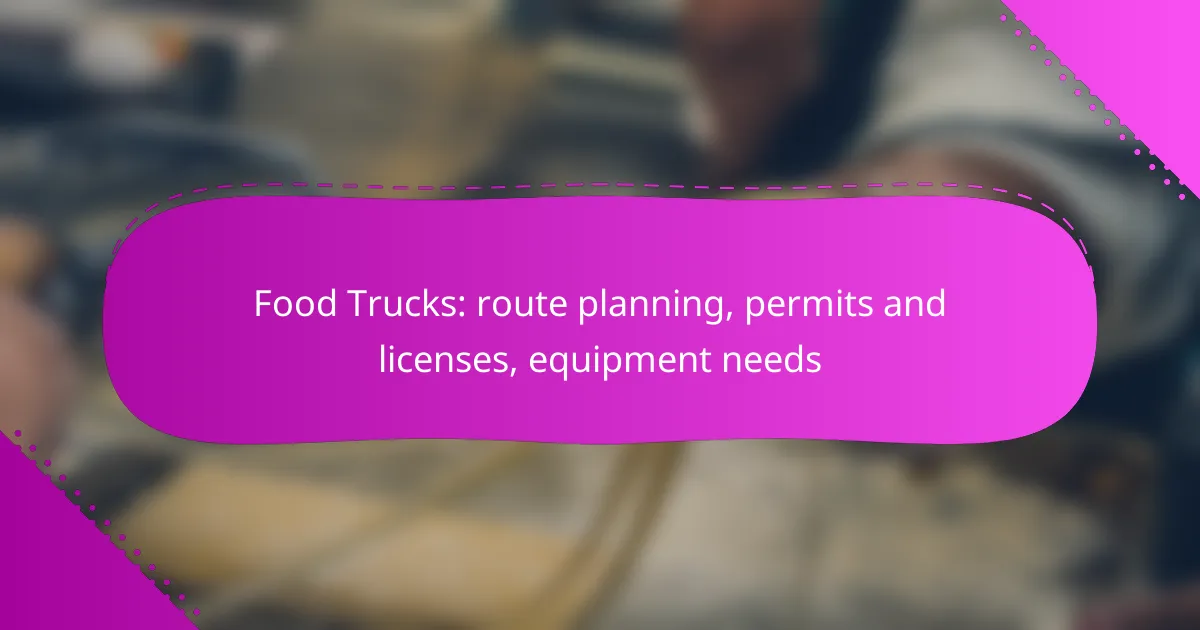Operating a food truck involves careful route planning to enhance sales and efficiency, utilizing technology to navigate local events and high-traffic areas. Additionally, obtaining the necessary permits and licenses, such as a business license and health department permits, is crucial for legal compliance. Equipping your food truck with essential appliances and systems ensures smooth operations and adherence to health regulations.

How to plan a food truck route in Canada?
Planning a food truck route in Canada involves strategic considerations to maximize sales and efficiency. Key factors include using technology for optimization, understanding local events, analyzing traffic, and identifying areas with high pedestrian activity.
Use route optimization software
Route optimization software can significantly enhance your food truck’s efficiency by calculating the best paths to take based on real-time data. These tools help minimize travel time and fuel costs, allowing you to serve more customers in less time.
Popular options include RoadWarrior and Google Maps, which can help you plan routes that avoid traffic congestion. Consider integrating software that allows for dynamic adjustments based on changing conditions, such as road closures or unexpected delays.
Consider local events and festivals
Local events and festivals can provide excellent opportunities for food trucks to attract large crowds. Research community calendars to identify upcoming events where you can set up your truck and maximize exposure.
Participating in these events often requires advance planning and possibly securing permits, so be proactive in reaching out to event organizers. Popular events may include farmers’ markets, music festivals, and sporting events, which can draw significant foot traffic.
Analyze traffic patterns
Understanding traffic patterns is crucial for effective route planning. Analyze peak hours in different areas to determine when and where to position your food truck for the best sales opportunities.
Utilize local traffic reports and historical data to identify trends, such as busy lunch spots during weekdays or popular nightlife areas on weekends. This analysis will help you make informed decisions about your daily routes.
Identify high foot traffic areas
High foot traffic areas are prime locations for food trucks, as they increase visibility and customer access. Look for spots near office buildings, universities, and shopping districts where large groups of people gather.
Consider using tools like Google Maps to assess pedestrian traffic and observe potential locations during different times of the day. Engaging with local businesses can also provide insights into where foot traffic is highest, helping you choose optimal locations for your food truck.

What permits and licenses are needed for food trucks in Canada?
Food trucks in Canada require several permits and licenses to operate legally, including a business license, health department permits, and a specific food truck permit. Additionally, compliance with local zoning regulations is essential to ensure proper operation within designated areas.
Obtain a business license
The first step in starting a food truck is obtaining a business license, which is mandatory in most provinces and municipalities. This license legitimizes your business and allows you to operate within your chosen area. Check with your local city or municipal office to understand the specific requirements and fees associated with obtaining this license.
Typically, the application process involves submitting your business name, address, and ownership details, along with any applicable fees. Ensure that your business name is unique and not already in use to avoid delays.
Secure health department permits
Health department permits are crucial for food trucks, as they ensure compliance with food safety regulations. These permits often require an inspection of your food truck to verify that it meets health and safety standards. You will need to demonstrate proper food handling, storage, and sanitation practices.
To secure these permits, contact your local health department for guidelines and application procedures. Be prepared to provide details about your menu, food sourcing, and preparation methods. Regular inspections may be required to maintain your permit.
Apply for a food truck permit
A food truck permit is specific to mobile food vendors and is required in many areas across Canada. This permit allows you to operate your food truck in designated locations and at events. The application process may vary by municipality, so it’s essential to check local regulations.
When applying, you may need to provide your business license, health permits, and proof of insurance. Fees for food truck permits can vary widely, so budget accordingly. Some cities may also have restrictions on where food trucks can park or operate, so familiarize yourself with these regulations.
Check local zoning regulations
Local zoning regulations dictate where food trucks can operate, which is critical for compliance. These regulations may specify permitted areas, hours of operation, and proximity to other businesses or residential areas. Understanding these rules helps avoid fines and ensures your food truck can serve customers effectively.
Consult your local zoning office or website for detailed information on regulations affecting food trucks. It’s advisable to map out potential locations and confirm their compliance with zoning laws before launching your business. This proactive approach can save time and resources in the long run.

What equipment is essential for a food truck?
Essential equipment for a food truck includes commercial kitchen appliances, point of sale systems, food storage solutions, and cooking and serving utensils. Each of these components plays a crucial role in ensuring efficient operations and compliance with health regulations.
Commercial kitchen appliances
Commercial kitchen appliances are vital for food preparation and cooking in a food truck. Key appliances include grills, fryers, ovens, and refrigerators, which must meet health and safety standards. When selecting equipment, consider the size of your truck and the menu you plan to offer, as this will influence the type and number of appliances needed.
Investing in energy-efficient appliances can help reduce operating costs over time. Look for models that are certified by relevant health authorities to ensure compliance with local regulations.
Point of sale systems
A reliable point of sale (POS) system is crucial for managing transactions and inventory in a food truck. Modern POS systems often include features like mobile payment options, sales tracking, and inventory management, which streamline operations and enhance customer experience. Choose a system that integrates well with your menu and offers user-friendly interfaces.
Consider systems that allow for offline functionality, as food trucks may operate in areas with limited internet access. Additionally, ensure that the POS system complies with local tax regulations and can handle various payment methods.
Food storage solutions
Food storage solutions are essential for maintaining food safety and quality in a food truck. This includes refrigeration units, dry storage containers, and proper labeling systems. Ensure that your refrigeration units are capable of maintaining safe temperatures for perishable items, typically below 40°F (4°C).
Invest in airtight containers for dry goods to prevent contamination and spoilage. Regularly check inventory levels and implement a first-in, first-out (FIFO) system to minimize waste and ensure freshness.
Cooking and serving utensils
Cooking and serving utensils are necessary for food preparation and customer service in a food truck. Essential items include spatulas, tongs, knives, and serving containers. Choose durable, easy-to-clean materials that can withstand high temperatures and frequent use.
Organize utensils in a way that allows for quick access during busy service times. Consider investing in portable storage solutions to keep your workspace tidy and efficient, which is crucial in the limited space of a food truck.

How to choose the right food truck equipment?
Selecting the right food truck equipment is crucial for operational efficiency and menu success. Consider your menu items, available space, and energy consumption to make informed choices that enhance your service and meet local regulations.
Assess menu requirements
Your menu dictates the type of equipment needed in your food truck. For example, if you plan to serve burgers, you’ll need a grill, fryer, and refrigeration for ingredients. Conversely, a coffee truck may require espresso machines and blenders instead.
Evaluate the volume of food you expect to serve. High-demand items may necessitate larger or multiple pieces of equipment to keep up with customer orders. Always prioritize equipment that aligns with your culinary vision while considering the space constraints of your truck.
Evaluate space and layout
Space is a critical factor in food truck equipment selection. Measure your truck’s interior dimensions to ensure that all equipment fits comfortably without obstructing workflow. A well-organized layout can significantly enhance efficiency during busy service periods.
Consider the flow of operations when arranging equipment. Place frequently used items, like grills and fryers, within easy reach of the serving window. This setup minimizes movement and speeds up service, which is essential during peak hours.
Consider energy efficiency
Energy-efficient equipment can reduce operational costs and environmental impact. Look for appliances with high energy ratings or those that utilize alternative energy sources, such as propane or solar power, especially if you plan to operate in areas with strict emissions regulations.
Investing in energy-efficient equipment may have a higher upfront cost, but it can lead to significant savings over time. Additionally, consider the availability of power sources at your operating locations to ensure your equipment can function optimally without interruptions.
